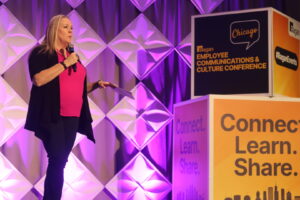Rx for RTO: Designing and sharing an expectations charter
How this charter functions as a culture, wellbeing and purpose agreement across stakeholders.

When members of the Ragan community share their stresses about return-to-office (RTO) mandates, the most common grievance centers around how RTO is implemented and enforced. Arbitrary rationale, purpose and business cases lead to half-hearted participation. What often follows has resulted in some contentious executive communications and enforcement strategies.
It doesn’t need to be this way.
Those who want to implement an RTO strategy and still maintain a culture of wellbeing, believes Mark Mohammadpour, Founder and CEO at Chasing the Sun, must start by defining where culture exists in the relationship between employees and the company.
“Not with the entire enterprise, not with hundreds or thousands of people,” he said, “but with their immediate team.”
When we can redefine wellbeing beyond wellness and physical health, it helps employees wake up every day able to answer the question of why they work there.
“It’s a challenge, but this is also an opportunity for us as communicators to really step up, be strategic and talk about the impact,” Mohammadpour explained. “If we don’t talk about this, you’re going to lose your people, because they’re going to go to companies that are much more specific on their RTO policies and ultimately have a better understanding of what their life is like.”
Mohammadpour shared his wisdom on how to create an expectations charter that functions as a culture, wellbeing and purpose agreement across all stakeholders.
Your charter is an agreement across your workstream
Mohammadpour suggests that teams looking to implement a culture-first RTO policy start with designing a team expectations charter. This charter is a wider commitment across key stakeholders in the organization, along with customers and prospective employees, that defines the team’s purpose.
Crucial components of this charter, Mohammadpour said, should include what your workforce does, what’s in scope, what’s outside of scope and how the work is delivered. He showed a hub and spoke infographic where “our commitments” are the central core, and crucial elements emanate out from it.
“The core document includes our commitments as a team,” he explained. “Things like why do we come into the office and for what purpose, how vacation is protected, what are your core hours, meetings, streamlined communications channels, and how do you ensure you understand your priorities?”
Don’t forget your customer or external audiences in this rationale either—they are central to framing the logic behind RTO.
“What is the need of the customer to determine whether we need to come back to the office?” asked Mohammadpour.
“Of course, there are certain companies that must have people in a physical space to do what’s right by the customer or the client. But we often skip that discussion when it comes to RTO. We focus primarily on ourselves to be able to make that determination. Is it truly a benefit for the customer for us to be back in the office five days a week, four days a week, three days a week—and for what purpose?”
Fitting RTO into the charter
Through this lens and framing, defining expectations for RTO can exist as a specific callout—and be supported by the other components.
Mohammadpour recalls workshopping one charter with a client and figuring out the team will be on the office Monday, Tuesday and Thursday. The expectation on those days was a focus on in-person meetings to advance the business, meet with clients and more. Wednesdays and Fridays were defined as heads-down days at home to work on things that didn’t require meetings.
“It met a number of purposes,” he said. “It had specific areas and times in which people would come together and be able to help ideate challenges in-person and host in-person client conversations. It also gave people the flexibility on specific days they knew to be able to block out time to do heads down work.”
It also gave people the freedom to know how they could plan long vacations and long weekends, knowing they wouldn’t need to be in the office on Friday and risk missing something important.
“It started during the pandemic and throughout there was zero turnover,” he said. “And there continues to be very little turnover within the organization as a result. This is something we work with teams on in real time, based on in agreement between the workstream that’s in context to HR policies—not designed to usurp them, but within the confines and the needs of what that workstream needs to accomplish.”
Making adjustments
This charter should be refreshed consistently, and Mohammadpour recommends revisiting it every six months with a discussion on what needs to be refreshed.
“It’s not written in ink, it’s written in dark pencil, so it can be erased or adjusted,” he said, citing Slack’s research and initiatives to limit the amount of employee meetings.
“At Slack, we avoid cluttering calendars with status meetings that are best handled asynchronously and instead post updates in a channel,” said Christina Janzer, svp of research and analytics at Slack. “We find the most valuable meetings have a clear, previously agreed upon purpose and end after that purpose has been achieved, rather than extending to the full 30 minutes or one hour default.”
Slack has instituted no-meeting Focus Fridays and Maker Weeks to also optimize its meeting culture. On Focus Fridays, teams cancel internal meetings and disable notifications to have uninterrupted focus time. During Maker Weeks, teams cancel recurring internal meetings and focus on creating, whether that’s coding, writing, planning or something else.
“This break in regularly scheduled meetings encourages teams to reevaluate their calendars and ask, did we really need that meeting at all?,” said Janzer.
“That’s a perfect example of making sure that we are constantly readjusting how we’re working together,” said Mohammadpour.
Keeping employees accountable
Framing each element of the charter around commitments, then contextualizing where RTO fits into the story as part of those commitments makes a lot of sense. But it’s also a baseline accountability and enforcement mechanism for driving the desired behaviors. Managers should feel empowered to point back to the charter should employees not show up and have an actionable backup plan for next steps.
What would that look like in practice? It starts with ensuring is prepared as possible for when uncertainties arise that range from meetings getting rescheduled to people unable to make it in.
“If I were working with a team on this, I’d brainstorm with the group a number of common scenarios that take place,” said Mohammadpour. “This approach is similar to a crisis plan that we would write for companies or clients.”
He shared a hypothetical example of a company where many employees often take the week between Christmas and New Year’s off. “We should be talking about the requirements of those people who are not taking that time off ahead of time,” he said. “Are they required to come into the office? Are they not? Making a decision ahead of time (ensures) we’re not causing stress or anxiety.”
Other specific cases may include employees with no specific meetings on an RTO day, or new employees who are yet to have a fully stacked schedule. Gaming out guidelines and best practices for these specific cases all contribute to a considerate, mindful employee experience.
Defining your ‘why’ behind RTO helps employees stay
These specificities ultimately require communicators to help leaders be more prescriptive about how they will get to know people, but they ultimately inform the “why” behind an RTO mandate. “There is value coming into the office for, as an example, professional development. But this needs to be made crystal clear as the opportunity going forward for the employee,” said Mohammadpour.
“If we don’t put those conversations into context and just say come in Tuesday, Wednesday, Thursday to have the exact same experience Monday through Friday, employees won’t understand the purpose.”
While communicators understand that building relationships are key, helping leaders understand that also means using your charter to define the intention behind RTO and validate remote work as a crucial piece of the puzzle that has long-term effects.
“We’re no longer at companies for 40 years,” Mohammadpour said. “How we deliver this and communicate the message doesn’t just have short-term impact. It’s a long-term relationship between the employer, whether that’s at the brand level or the individual manager level, and the employee. The chapters of our careers are getting shorter and shorter, and the way we talk about topics like RTO will have an impact for decades.”
Learn more tips for implementing RTO strategies during Ragan’s Employee Experience and Culture Conference this April in Chicago. Register now!








